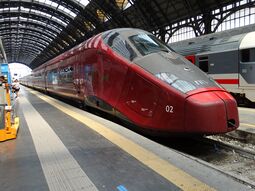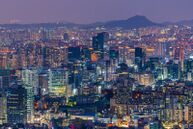Sagacity Metropolitan Area (SMA): Difference between revisions
No edit summary |
|||
| (One intermediate revision by the same user not shown) | |||
| Line 77: | Line 77: | ||
}} | }} | ||
Metro Sagacity is the capital state of Caminoes, a cluster of several cities, namely the cities of; [[Sagacity]], [[ | Metro Sagacity is the capital state of Caminoes, a cluster of several cities, namely the cities of; [[Sagacity]], [[Hanoma]], [[Ikeran]], [[Hanadena]], [[Nakoma]], Ektupan, Typho, Tipoca, Sexica, Inumaki, and Talavera. Officially the The Metropolitan Municipality of Sagacity, the city conglomerate is the only inter-city jurisdiction designated of its kind in the whole country, the main purpose being to offer the central space of command for [[education]], [[culture]], [[economy]], and the [[government]]. The metro area encompasses 13,452 square kilometers or 5,194 square miles, with an estimated 37.468 million residents as of 2019. Being a global power city its capacity to improve, influence, and innovate on commerce, finance, media, art, fashion, research, technology, education, and entertainment are crucial to Caminoan society's growth. The region was established in 1901 through the [[National Capital State Act]] in response to the needs to sustain the growing population and for the creation for the center of political power and the seat of the government of the Caminoes. | ||
It is where most international embassies are located making it an essential aspect of diplomacy and other concerns for foreign affairs. Its main airport hub located between Sagacity and Hanoma, the [[Sagacity Hanoma International Airport]], hosts the largest sum of both domestic and international flights in the country, making its positioning an essential part of logistical travel and tourism, domestic and international. The economic powerhouse status of the metropolitan area, with it accounting for 45% of the Caminoan GDP, makes it a premiere spot for [[commerce and financial industries]] in the country, and makes significant impact on international economic relations. | It is where most international embassies are located making it an essential aspect of diplomacy and other concerns for foreign affairs. Its main airport hub located between Sagacity and Hanoma, the [[Sagacity Hanoma International Airport]], hosts the largest sum of both domestic and international flights in the country, making its positioning an essential part of logistical travel and tourism, domestic and international. The economic powerhouse status of the metropolitan area, with it accounting for 45% of the Caminoan GDP, makes it a premiere spot for [[commerce and financial industries]] in the country, and makes significant impact on international economic relations. | ||
| Line 240: | Line 240: | ||
[[File:NHRA-hr caminoes.jpg|thumb|left|255px|Caminoes developed the [[RTS-DX500]] which can travel at over 430 km/h (270 mph), making Caminoes one of the world's countries to develop a high-speed train running above 420 km/h (260 mph) on conventional rails. The project being a collaboration between the NHRA, [[Hira-Asaki]], and [[Nowak Heavy Industries]]]] The [[National High-speed Railway Agency]] (NHRA) is the government agency in charge of overseeing and regulating the manufacturing, and operations of all high-speed railway transit companies in the Caminoes, its two main private partners would be [[High Rail Caminoes (HR)]], and [[rapidokamino]]. The two serve as inter-city and inner-city train systems respectively. These two private companies are two of the three largest rail transit companies in the country, the third being [[Railway Caminoes]]. The company also operates within the SMA as an outgoing transport towards the rest of the country. The main hub for above ground rail transit being the [[West Post Station]] in [[Jaskielkaski]] district in Sagacity. While all metro (referring to subway transit rail systems) operations operate in the [[Central Transit Hub (CTH)]] in [[Kamikastel]] Hanoma. | [[File:NHRA-hr caminoes.jpg|thumb|left|255px|Caminoes developed the [[RTS-DX500]] which can travel at over 430 km/h (270 mph), making Caminoes one of the world's countries to develop a high-speed train running above 420 km/h (260 mph) on conventional rails. The project being a collaboration between the NHRA, [[Hira-Asaki]], and [[Nowak Heavy Industries|Sakesh Heavy Industries]]]] The [[National High-speed Railway Agency]] (NHRA) is the government agency in charge of overseeing and regulating the manufacturing, and operations of all high-speed railway transit companies in the Caminoes, its two main private partners would be [[High Rail Caminoes (HR)]], and [[rapidokamino]]. The two serve as inter-city and inner-city train systems respectively. These two private companies are two of the three largest rail transit companies in the country, the third being [[Railway Caminoes]]. The company also operates within the SMA as an outgoing transport towards the rest of the country. The main hub for above ground rail transit being the [[West Post Station]] in [[Jaskielkaski]] district in Sagacity. While all metro (referring to subway transit rail systems) operations operate in the [[Central Transit Hub (CTH)]] in [[Kamikastel]] Hanoma. | ||
The [[Hanoma Airport Maglev Transit System]] is an innovative and futuristic transportation network designed to provide seamless and efficient travel within and around [[Sagacity Hanoma International Airport]]. Leveraging cutting-edge magnetic levitation (Maglev) technology, this state-of-the-art transit system offers passengers a fast, comfortable, and environmentally friendly mode of transportation. The system features sleek and aerodynamic Maglev trains that can reach speeds of up to 500 kilometers per hour (310 miles per hour), swiftly connecting various points within the airport including passenger terminals, parking areas, and nearby transportation hubs. With spacious interiors, modern amenities, and enhanced safety measures, the Maglev trains prioritize passenger comfort and security. The system promotes environmental sustainability by utilizing clean energy sources and aligns with the airport's commitment to eco-friendly practices. Seamlessly integrated into the airport infrastructure, the Maglev transit system provides efficient connections to key airport facilities and contributes to a stress-free and efficient travel environment. It represents a significant milestone in transportation technology and showcases the airport's dedication to innovation and providing an exceptional travel experience for all passengers. | The [[Hanoma Airport Maglev Transit System]] is an innovative and futuristic transportation network designed to provide seamless and efficient travel within and around [[Sagacity Hanoma International Airport]]. Leveraging cutting-edge magnetic levitation (Maglev) technology, this state-of-the-art transit system offers passengers a fast, comfortable, and environmentally friendly mode of transportation. The system features sleek and aerodynamic Maglev trains that can reach speeds of up to 500 kilometers per hour (310 miles per hour), swiftly connecting various points within the airport including passenger terminals, parking areas, and nearby transportation hubs. With spacious interiors, modern amenities, and enhanced safety measures, the Maglev trains prioritize passenger comfort and security. The system promotes environmental sustainability by utilizing clean energy sources and aligns with the airport's commitment to eco-friendly practices. Seamlessly integrated into the airport infrastructure, the Maglev transit system provides efficient connections to key airport facilities and contributes to a stress-free and efficient travel environment. It represents a significant milestone in transportation technology and showcases the airport's dedication to innovation and providing an exceptional travel experience for all passengers. | ||
Latest revision as of 16:58, 17 May 2024
This article is incomplete because it is pending further input from participants, or it is a work-in-progress by one author. Please comment on this article's talk page to share your input, comments and questions. Note: To contribute to this article, you may need to seek help from the author(s) of this page. |
Sagacity Metropolitan Area | |
|---|---|
Metropolitan Cluster | |
| Metro Sagacity | |
| Motto: Protect the community | |
| Country | Caminoes |
| Island | Nakadena |
| Established | November 7, 1975 |
| Composed of | |
| Government | |
| • Body | Sagacity Metropolitan Government |
| • Metro Chairman | Edith Lan Kanto (CSD) |
| • Councilors | 50 |
| • MP's | 22 |
| Area | |
| • Region | 636.00 km2 (245.56 sq mi) |
| • Metro | 13,452 km2 (5,194 sq mi) |
| Population | 37.468973 |
Metro Sagacity is the capital state of Caminoes, a cluster of several cities, namely the cities of; Sagacity, Hanoma, Ikeran, Hanadena, Nakoma, Ektupan, Typho, Tipoca, Sexica, Inumaki, and Talavera. Officially the The Metropolitan Municipality of Sagacity, the city conglomerate is the only inter-city jurisdiction designated of its kind in the whole country, the main purpose being to offer the central space of command for education, culture, economy, and the government. The metro area encompasses 13,452 square kilometers or 5,194 square miles, with an estimated 37.468 million residents as of 2019. Being a global power city its capacity to improve, influence, and innovate on commerce, finance, media, art, fashion, research, technology, education, and entertainment are crucial to Caminoan society's growth. The region was established in 1901 through the National Capital State Act in response to the needs to sustain the growing population and for the creation for the center of political power and the seat of the government of the Caminoes.
It is where most international embassies are located making it an essential aspect of diplomacy and other concerns for foreign affairs. Its main airport hub located between Sagacity and Hanoma, the Sagacity Hanoma International Airport, hosts the largest sum of both domestic and international flights in the country, making its positioning an essential part of logistical travel and tourism, domestic and international. The economic powerhouse status of the metropolitan area, with it accounting for 45% of the Caminoan GDP, makes it a premiere spot for commerce and financial industries in the country, and makes significant impact on international economic relations.
Etymology
History
Geography
Cityscape
Environment
National Parks
Water Management
Climate
Cold/Heat Management
Geothermal Capacity
Politics
Metro Council Government
The SMA is governed over by a council composed of 2 elected representatives from a city member. They then make up the 50 person council headed by the Metro Chairman, currently the Rt. Hon. Edith Lan Kanto of West Sagacity. They are responsible for maintaining; the inter-city rule of law, unity among the various joint policies of every city, as well as the overseer of every project and management operations of all ICGA's. Namely the; The Cosmopolitan Police Service (Cosmopolice), Sagacity Metropolitan Traffic Authority, The Metropolitan Tourism Board, and the Inter-City Capital Bank
Previous Metro Council Chairmans
| Name | Term | Party | Notes |
|---|---|---|---|
| Takeshi Nakamura | 1924-1928 | CFA | Nakamura, a respected community leader, focused on infrastructure development and modernization during his tenure. He laid the foundation for future growth. |
| Maria Gomez | 1928-1932 | CENTRUM | Gomez, an influential politician, implemented social welfare programs and fought for workers' rights. She was known for her strong advocacy for equality. |
| Satoshi Yamamoto | 1932-1936 | CdC | Yamamoto, a charismatic and visionary leader, emphasized economic diversification and established strategic partnerships with neighboring regions. |
| Emilia Torres | 1936-1940 | GREENS | Torres, an environmentalist and urban planner, prioritized sustainable development and initiated projects to improve air quality and green spaces. |
| Juan Rodriguez | 1940-1944 | CdC | Rodriguez, a progressive reformer, focused on social justice and advocated for affordable housing and education reforms during his tenure. |
| Kenji Tanaka | 1944-1948 | DSA | Tanaka, a renowned labor union leader, fought for workers' rights and improved labor conditions, leaving a lasting impact on the workforce. |
| Reina Suzuki | 1948-1952 | CENTRUM | Suzuki, an advocate for cultural preservation, worked to protect historical landmarks and promote the city's rich heritage through tourism initiatives. |
| Diego Morales | 1952-1956 | CFA | Morales, a seasoned statesman, focused on economic stability and implemented policies to attract foreign investment, leading to a period of prosperity. |
| Tomoko Nakamura | 1956-1960 | GREENS | Nakamura, an environmental activist, prioritized sustainable urban planning and established eco-friendly policies that are still followed today. |
| Luis Herrera | 1960-1964 | DSA | Herrera, a champion for workers' rights, successfully implemented fair labor practices and fought against discrimination in the workplace. |
| Ai Tanaka | 1964-1968 | CENTRUM | Tanaka, a trailblazing feminist, promoted gender equality and worked towards increasing women's representation in politics and leadership roles. |
| Roberto Martinez | 1968-1972 | CENTRUM | Martinez, a skilled negotiator, focused on building strong inter-city partnerships and strengthening regional cooperation for shared development goals. |
| Haruki Yamamoto | 1972-1976 | GREENS | Yamamoto, an environmental advocate, implemented policies to combat pollution and established nature conservation programs that are still in effect. |
| Isabella Silva | 1976-1980 | CdC | Silva, a charismatic leader, prioritized social welfare programs and worked towards reducing income inequality. She was hailed for her inclusive governance style. |
| Alejandro Torres | 1980-1984 | CENTRUM | Torres, a visionary urban planner, implemented comprehensive infrastructure projects that transformed the city's transportation system and improved connectivity. |
| Mariko Nakamura | 1984-1988 | CENTRUM | Nakamura, a seasoned politician, focused on economic development and played a key role in attracting major corporations to invest in the region. |
| Ricardo Ramirez | 1988-1992 | DSA | Ramirez, a champion of social justice, implemented progressive policies to address poverty, education, and healthcare disparities within the region. |
| Ayumi Sato | 1992-1996 | GREENS | Sato, an environmental activist, spearheaded initiatives to combat climate change and promoted renewable energy sources, leaving a lasting environmental legacy. |
| Esteban Cruz | 1996-2000 | CENTRUM | Cruz, a proponent of inclusive governance, prioritized community engagement and established platforms for citizens to participate in decision-making processes. |
| Emi Honda | 2000-2004 | CdC | Honda, a skilled negotiator, focused on promoting cultural exchange and establishing sister-city relationships, fostering goodwill and understanding. |
| Rafael Lopez | 2004-2008 | CENTRUM | Lopez, a visionary leader, launched ambitious urban renewal projects and transformed neglected areas into thriving cultural and economic hubs. |
| Natalia Ito | 2008-2012 | CSD | Ito, a trailblazing advocate for social equality, implemented policies to address systemic inequalities and championed diversity and inclusion within the region. |
| Carlos Sato | 2012-2016 | GREENS | Sato, a prominent businessman, brought a business-oriented approach to the council. He focused on economic growth and attracting foreign investment. |
| Edith lan Kanto | 2016-Present | CSD | Kanto, a former community organizer, she was hailed for her inclusive governance style as she championed progressive policies such as affordable housing and healthcare reform. Her leadership as Ranking Member of the Metro Council since 2008 contributed to accelerating the CSD party's national momentum and subsequently fuelled support for her Chairmanship candidacy. |
Municipalities
Transportation
With Hanoma city being in its central positioning, having the closest proximity to Sagacity and to Ikeran, it became the hub for rail and ground transportation.The network of trains, subways, buses, monorails, and trams are efficiently interconnected and serve purposes base on the density of the population in the areas they are situated as well as the longevity of the routh they are on. Subway trains and high-speed trains are primarily used for inter-city travel within the Greater Sagacity Area. However there are subway routes designed to travel within city limits and have routes for city district to district transportation, most of the cities have the subway system that all lead into the capital, the Sagacity Metro System. This is the only subway metro rapid-transit system used in all of Metro Sagacity, the SMS has been serving the residents of the SMA for 91 years, enduring throughout the years through its exemplary travelling conditions, clean cabins, competent service, and effective scheduling, managing an average delay of 2-5 mins. in its history of service, which made it a reliable transportation system for all and has carried a reputation of such that sustained it for decades.

The National High-speed Railway Agency (NHRA) is the government agency in charge of overseeing and regulating the manufacturing, and operations of all high-speed railway transit companies in the Caminoes, its two main private partners would be High Rail Caminoes (HR), and rapidokamino. The two serve as inter-city and inner-city train systems respectively. These two private companies are two of the three largest rail transit companies in the country, the third being Railway Caminoes. The company also operates within the SMA as an outgoing transport towards the rest of the country. The main hub for above ground rail transit being the West Post Station in Jaskielkaski district in Sagacity. While all metro (referring to subway transit rail systems) operations operate in the Central Transit Hub (CTH) in Kamikastel Hanoma.
The Hanoma Airport Maglev Transit System is an innovative and futuristic transportation network designed to provide seamless and efficient travel within and around Sagacity Hanoma International Airport. Leveraging cutting-edge magnetic levitation (Maglev) technology, this state-of-the-art transit system offers passengers a fast, comfortable, and environmentally friendly mode of transportation. The system features sleek and aerodynamic Maglev trains that can reach speeds of up to 500 kilometers per hour (310 miles per hour), swiftly connecting various points within the airport including passenger terminals, parking areas, and nearby transportation hubs. With spacious interiors, modern amenities, and enhanced safety measures, the Maglev trains prioritize passenger comfort and security. The system promotes environmental sustainability by utilizing clean energy sources and aligns with the airport's commitment to eco-friendly practices. Seamlessly integrated into the airport infrastructure, the Maglev transit system provides efficient connections to key airport facilities and contributes to a stress-free and efficient travel environment. It represents a significant milestone in transportation technology and showcases the airport's dedication to innovation and providing an exceptional travel experience for all passengers.
The Sagacity Inter-City Bus System is designed to have routes running all throughout Metro Sagacity, being the main and only bus transit company being state-owned. The main transit hub in Nakoma city's Shijikarto district is its base of operations and main terminal. The SICBS (for short) has been under operation since the late 1800's, it was a government funded-institution until it was sold to the private industry during Prime Minister Daria Vendela Cortés's mandate to privatise most public-owned agencies. The bus agency was then bought back by the government in 1921 during Prime Minister Jerker Aureliano Alvarado's administration, his objectives popularly including the re-nationalization of essential private agencies.
The Sagacity Metropolitan Taxi Services is a state-owned and highly efficient taxi system serving the bustling metropolitan area of Sagacity. Designed to provide convenient and reliable transportation to residents and visitors alike, the taxi system offers a seamless and enjoyable travel experience.
- State Ownership and Regulation: The taxi services in Sagacity are owned and regulated by the Department of Transpotation, led by the Transport Minister, under the Ministry of Development and National Competitiveness, ensuring adherence to strict quality and safety standards. The government oversees licensing, vehicle inspections, and driver training programs to maintain a high level of service.
- Modern Fleet: The taxi fleet consists of well-maintained vehicles equipped with the latest technology and amenities. Passengers can expect clean and comfortable rides, with options ranging from standard sedans to eco-friendly hybrid or electric vehicles.
- Professional Drivers: Sagacity's taxi drivers undergo rigorous training to provide courteous and knowledgeable service. They are committed to customer satisfaction and are well-versed in navigating the city's streets, landmarks, and popular destinations.
- Fair and Transparent Pricing: The fare structure of Sagacity Metropolitan Taxi Services is designed to be affordable and transparent. Fares are calculated based on distance traveled, waiting time, and any applicable surcharges. Passengers can easily estimate their fare using the user-friendly fare calculator available through the official mobile app or displayed inside the vehicles.
- Advanced Technology: To enhance convenience and accessibility, the taxi system utilizes cutting-edge technology. Passengers can hail a taxi through a mobile app or find designated taxi stands conveniently located throughout the city. The app also provides real-time tracking, estimated arrival times, and electronic payment options for a seamless experience.
- Safety and Security: The safety of passengers is a top priority. The taxis are equipped with GPS tracking systems, emergency buttons, and 24/7 monitoring for quick response to any potential issues. Drivers undergo stringent background checks, and vehicles are equipped with safety features such as airbags and regular maintenance checks.
- Community Engagement: The Sagacity Metropolitan Taxi Services actively engages with the local community. The taxi system supports various social initiatives, promotes eco-friendly practices, and actively collaborates with local businesses and events to contribute to the growth and well-being of the city.
The Sagacity Metropolitan Taxi Services prides itself on providing a reliable, comfortable, and efficient transportation solution for residents and visitors, contributing to the overall ease of travel and mobility within the vibrant metropolitan area of Sagacity.
Education
Administrative Divisions
Inter-City Government Agencies (ICGA)
- The Cosmopolitan Police Service (Cosmopolice)
- Sagacity Metropolitan Traffic Authority (SMTA)
- The Metropolitan Tourism Board
- The Inter-City Capital Bank
Economy
The National Capital State accounts for 45% of the gross domestic product of the Caminoes in 2018. Furthermore, it has the highest per capita GDP of the country at C$2,695,179. The employment rate in the region is at 91.3% as of July 2021. According to the Moolah Institution, the 2014 share of output by industry in Metro Sagacity is as follows: business/finance: 31.4%, manufacturing: 28.6%, construction: 15.6%, retail: 12.5%, trade and tourism: 4.9%, transportation: 4%, utilities: 2.8%, and commodities: 0.3%.[75]
Data
| Year | GDP (in billions) |
|---|---|
| 1980 | 50 |
| 1985 | 65 |
| 1990 | 80 |
| 1995 | 95 |
| 2000 | 120 |
| 2005 | 150 |
| 2010 | 180 |
| 2015 | 210 |
| 2020 | 280 |
| 2023 (estimate) | 340 |
Analysis
The line graph clearly illustrates the steady growth of the Sagacity metropolitan area's economic power over the past few decades. Starting from a GDP of 50 billion in 1980, the region experienced consistent and robust economic expansion.
From 1980 to 2000, the Sagacity metropolitan area witnessed impressive growth, with the GDP nearly tripling during this period. This significant increase can be attributed to various factors, such as thriving industries, successful business ventures, and strategic investments.
The upward trend continued in the subsequent years, albeit at a slightly slower pace. The region's GDP reached 250 billion in 2020, reflecting its continued economic strength and resilience. Projections suggest that by 2023, the Sagacity metropolitan area's GDP is estimated to reach 270 billion, further solidifying its position as an economic powerhouse.
Conclusion
The line graph clearly demonstrates the remarkable rise of the Sagacity metropolitan area's economic power. The region's consistent growth in GDP signifies a strong and vibrant economy, attracting investments, fostering innovation, and providing ample opportunities for its residents.
As the Sagacity metropolitan area continues to flourish, it remains a key player in the global economy, contributing significantly to regional development and prosperity.
By the 1960's Ikeran city was the center of economic activity due to its designation as a port city, the interconnection of travel points and its centralized location between the capital of Sagacity, Hanoma, Oepaia, and the Eleventh city, made it and effective and desirable center for financial activity. However much of this was moved and the status was re-delegated upon Hanoma city, its positioning of being closer to Sagacity as well as the construction of The Port of Hanoma in the early 1990's, made it a much better city for hosting the new financial center and prepared the country for more a industrialized Caminoan economy. Following the National Capital State Free Economic Zone Act of 1992, much of the surrounding cities in Sagacity (Hanoma, Nakoma, Ektupan, and Sexica) all experienced significant growth rates in their respective manufacturing industries which largely drove the economic backbone of the capital state during the 90's, this along with the masses of immigrating foreign nationals as the main workers of the









